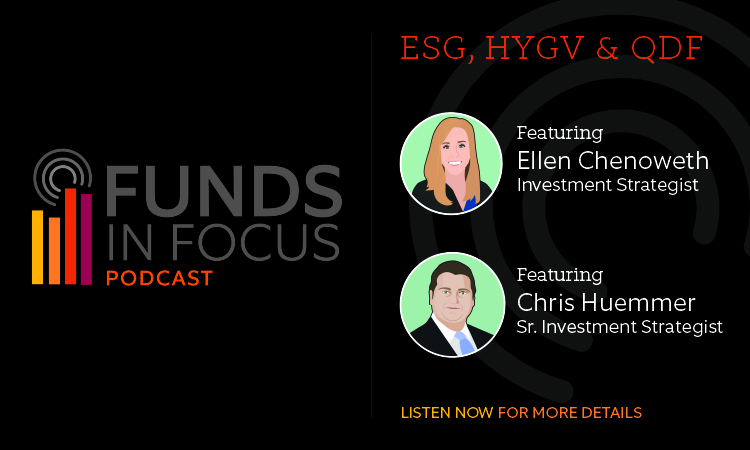As 2020 has come to a close, the challenging year has left investors with a lot of questions to consider. How long will it take for the global economy to recover? How will the tumultuous year behind us shape 2021? And how can investors position their portfolios for the year ahead?
In our final Funds in Focus podcast episode of the year, we spoke with Investment Strategists Christopher Huemmer and Ellen Chenoweth about their perspectives on the challenging year behind us and the new year ahead. As we pivot to 2021, Chris and Ellen shared three ideas that investors can implement in portfolios today:
In this episode, you'll learn
- What the key points that may impact the outlook for 2021
- A highlighted look at dividend stocks
- Why there is a focus on avoiding large sector bets and focusing on quality dividend paying companies
- How the environment and the search for yield can impact the high yield segment
- Value investing – and why investors may want to focus on this in the high yield segment
#1: DIVIDENDS IN LESS OBVIOUS PLACES
While the low interest rate environment continues to persist, earnings growth rates have slowed as the pandemic has taken a widespread toll on the economy. The combination of these two trends has many investors turning to dividends as a potential way to earn current income while participating in the earnings recovery.
However, when it comes to dividend-generating sectors, 2020 offered a lesson in looking beyond the usual suspects. Many investors believe that compelling dividend income can only be found in the industrials, utilities, financials, and sometimes even real estate sectors. But looking back on 2020, these sectors were among the hardest hit across equity markets—underscoring the importance of sourcing dividends from all sectors. For example, the dividend landscape has evolved such that the technology and healthcare sectors can also offer compelling dividend income.
When looking to evaluate dividend payers across sectors, it’s important to focus on the quality—or financial strength—of companies. This can help investors develop a better understanding of a company’s ability to grow its dividend over time, its profitability relative to its peers, and its cash flow management. This approach also widens the opportunity set, as it can encompass new dividend payers—not just those who’ve built a long dividend-paying track record.
#2: WHEN THE HUNT FOR YIELD LEADS TO HIGH YIELD
The continued hunt for yield has also led many investors to corporate bonds. We believe high yield bonds can offer an attractive income solution relative to investment grade corporate bonds, while still offering upside participation. Investment grade bonds1 are currently yielding around 1.9%, while high yield bond investors are compensating investors for more credit and default risk with a yield around 4.2%.2 And looking ahead, we expect high yield bonds to potentially benefit from increased demand from yield-seekers, improving leverage metrics, decreasing default rates, and tightening credit spreads as the economy recovers.
As high yield bonds have become more widely adopted in balanced portfolios, we’ve seen overall credit quality increase and income generation decrease. This has ultimately led to deteriorating credit premiums and a reduction in the risk and return tradeoff typically observed in the high yield market.
In order to remedy this, it’s important to evaluate high yield credit focus through a value lens—thereby potentially increasing credit premium exposure and improving diversification. And identifying securities trading below their intrinsic value can create the opportunity for capital appreciation, offering the potential for attractive long-term risk-adjusted returns.
#3: ESG CONTINUES TO ENDURE
Investors are increasingly looking beyond companies’ economic viability and are placing more importance on the sustainability of their business models through environmental, social and governance (ESG) lenses. Many investors who once had trouble aligning sustainable investing principles with traditional ones have begun to recognize that evaluating companies through an ESG lens doesn’t need to result in eroded returns. In fact, it can help them avoid the potential long-term risks and pitfalls associated with companies failing to adapt to the global shift toward sustainability.
The pandemic has further accelerated this trend, with ESG skeptics becoming fewer and farther between—and we expect this investing theme to continue into 2021 and beyond.
For more information on our related funds, please see our FlexShares Quality Dividend Index Fund (QDF), FlexShares High Yield Value-Scored Bond Index Fund (HYGV), and FlexShares STOXX® US ESG Impact Index Fund (ESG).
1 An investment grade is a rating that signifies a municipal or corporate bond presents a relatively low risk of default.
2 Investment grade corporate bonds measured by the Bloomberg Barclays U.S. Corporate Investment Grade Index. The Bloomberg Barclays US Corporate High Yield Bond Index measures the USD-denominated, high yield, fixed-rate corporate bond market.High Yield Bonds measures by the Bloomberg Barclays U.S. Corporate High Yield Index.The Bloomberg Barclays US Corporate Bond Index measures the investment grade, fixed-rate, taxable corporate bond market. It includes USD denominated securities publicly issued by US and non-US industrial, utility and financial issuers. Data as of 1/14/21.

